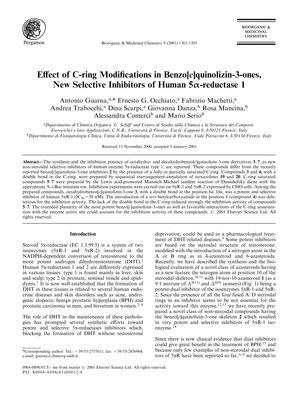Effect of C-Ring Modifications in Benzo[c]quinolizin-3-ones, New Selective Inhibitors of Human 5α-Reductase 1
June 2001
in “
Bioorganic & Medicinal Chemistry
”

TLDR Changing the C-ring structure in certain compounds can make them better at blocking a specific human enzyme.
In the 2001 study, researchers synthesized and evaluated the inhibitory potency of new non-steroidal selective inhibitors of human enzyme 5α-reductase type 1, with a focus on octahydro- and decahydrobenzo[c]quinolizin-3-one derivatives (compounds 3-7). The most potent inhibitor was found to be octahydrobenzo[c]quinolizin-3-one 3, with an IC50 value of 58 nM, which was selective for 5α-reductase type 1. The study highlighted that the unsaturation of the C-ring was crucial for the inhibitory activity, as compounds with a fully saturated C-ring showed a significant reduction in activity. The introduction of a tert-butylcarboxyamide at position 8 also reduced inhibitory activity. The study concluded that the planarity and specific interactions of the C-ring with the enzyme's active site were key to inhibition. The compounds were tested on CHO cells expressing human 5α-reductase types 1 and 2, but the number of cells or the exact experimental setup was not detailed in the summary.
![Benzo[c]quinolizin-3-ones: A Novel Class of Potent and Selective Nonsteroidal Inhibitors of Human Steroid 5α-Reductase 1](/images/research/ff6e6cbe-cb9c-4d11-87ef-671d28ffd4fa/small/15506.jpg)






![Effect of C-Ring Modifications in Benzo[c]quinolizin-3-ones, New Selective Inhibitors of Human 5α-Reductase 1](/images/research/c687900f-ea40-4de1-8f0b-a5b818951b1c/small/15452.jpg)